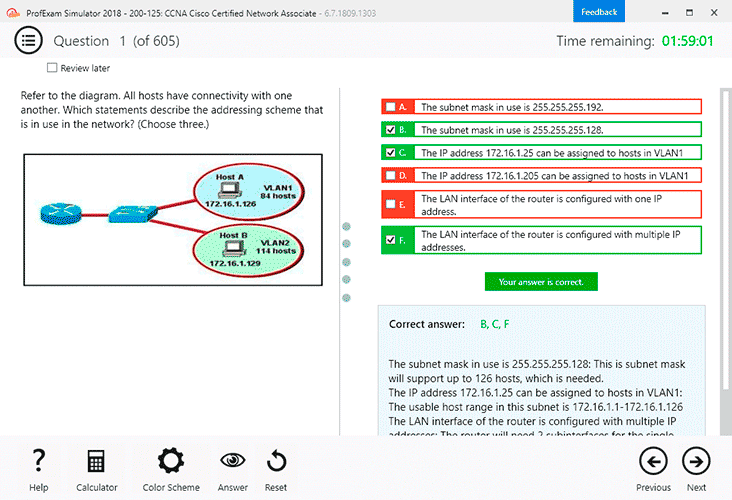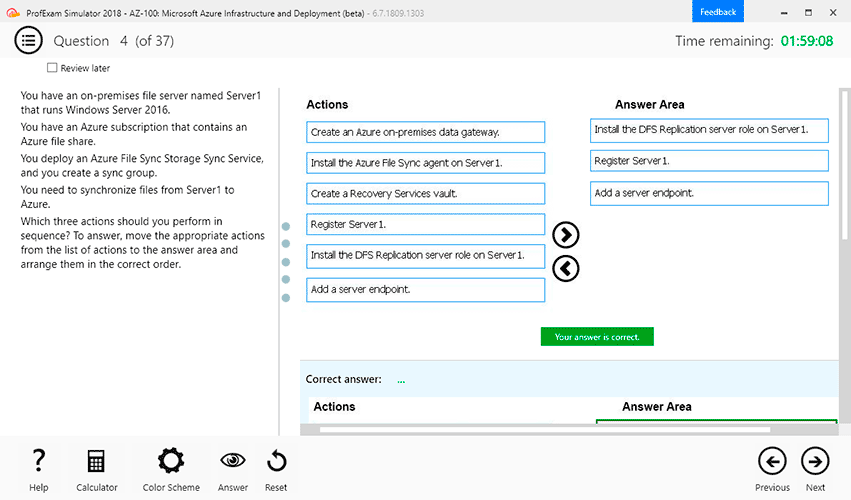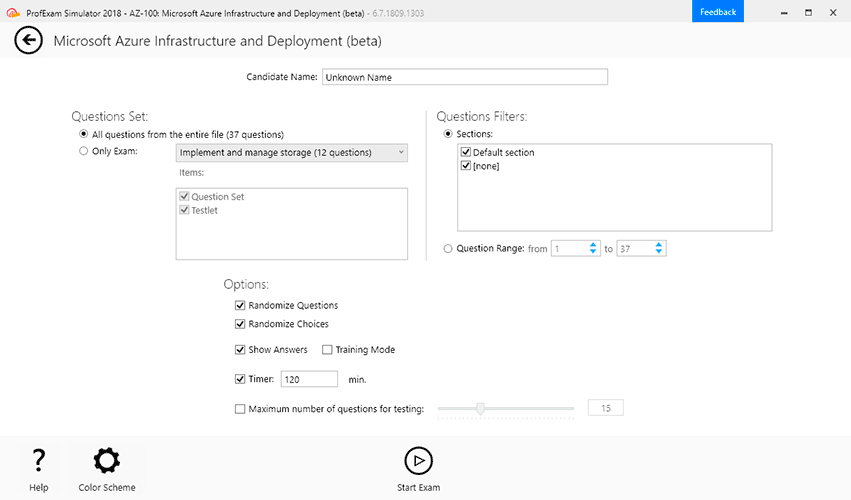File Info
| Exam | ISTQB Certified Tester - Performance Testing |
| Number | CT-PT |
| File Name | ISTQB.CT-PT.VCEplus.2025-03-22.23q.tqb |
| Size | 97 KB |
| Posted | Mar 22, 2025 |
| Download | ISTQB.CT-PT.VCEplus.2025-03-22.23q.tqb |
How to open VCEX & EXAM Files?
Files with VCEX & EXAM extensions can be opened by ProfExam Simulator.
Coupon: MASTEREXAM
With discount: 20%






Demo Questions
Question 1
Which of the following performance script types measures network response times?
- GUI scripts
- API scripts
- HTTP scripts
- Protocol-level scripts
Correct answer: D
Explanation:
Protocol-level scripts measure the actual response times of network requests, making them ideal for analyzing network latency, bandwidth issues, and server response times.Option A (GUI scripts) measure user interactions, not network timing.Option B (API scripts) measure API interactions but do not provide detailed network response time analysis.Option C (HTTP scripts) measure web requests but lack low-level network insights. Protocol-level scripts measure the actual response times of network requests, making them ideal for analyzing network latency, bandwidth issues, and server response times.
Option A (GUI scripts) measure user interactions, not network timing.
Option B (API scripts) measure API interactions but do not provide detailed network response time analysis.
Option C (HTTP scripts) measure web requests but lack low-level network insights.
Question 2
What is the primary purpose of a load generator?
- Create a steady and consistent background load on the system
- Simulate user behavior in accordance with the defined operational profile
- Record and analyze the behavior of the system as it is executing the prescribed tests
- Support root cause analysis when performance degradation is encountered
Correct answer: B
Explanation:
A load generator is responsible for simulating virtual users and applying workloads to a system as defined by an operational profile. This allows testers to analyze how the system behaves under different load conditions.Option A (Background load) is incorrect because load generators create simulated user interactions, not just background noise.Option C (Record and analyze behavior) is the role of monitoring tools, not a load generator.Option D (Support root cause analysis) is incorrect because root cause analysis is done after the load test, using monitoring tools. A load generator is responsible for simulating virtual users and applying workloads to a system as defined by an operational profile. This allows testers to analyze how the system behaves under different load conditions.
Option A (Background load) is incorrect because load generators create simulated user interactions, not just background noise.
Option C (Record and analyze behavior) is the role of monitoring tools, not a load generator.
Option D (Support root cause analysis) is incorrect because root cause analysis is done after the load test, using monitoring tools.
Question 3
You are managing the testing efforts of an existing distributed system that manages inventories of automobile and light truck tires from multiple warehouses across the country. The system is being enhanced to track incoming restocking shipments at the point of entry to the warehouse and outbound sales shipments at the point of shipment from the warehouse, all of which are executed in real-time. System loads traditionally peak on Mondays due to built-up demand from the previous weekend.
You are constructing an operational profile that emulates entities that submit large, bulk orders of greater than or equal to 1600 tires per transaction. You feel the profile you are constructing accurately reflects this type of power purchaser.
Which of the following steps must you take to ensure your operational profile is accurate?
- Execute the performance test with the operational profile and adjust the parameters as needed.
- Review and adjust the profile with key stakeholders prior to using it.
- Aggregate the specific operational profiles into a single generic profile and use that generic profile for load testing.
- Based on the power purchaser information, create operational profiles for low and medium purchasers and use equal proportions of those profiles during the testing.
Correct answer: B
Explanation:
To ensure an accurate operational profile, it is crucial to validate and adjust it with key stakeholders before executing tests. This step ensures that the workload realistically represents actual user behavior.Option A (Executing the test first and adjusting later) is incorrect because adjustments should be made before execution to avoid misleading results.Option C (Aggregating profiles into a single generic profile) removes important distinctions between different user types, reducing test accuracy.Option D (Creating separate profiles and using equal proportions) does not match the actual power purchaser behavior, which requires a realistic representation of their higher-volume transactions. To ensure an accurate operational profile, it is crucial to validate and adjust it with key stakeholders before executing tests. This step ensures that the workload realistically represents actual user behavior.
Option A (Executing the test first and adjusting later) is incorrect because adjustments should be made before execution to avoid misleading results.
Option C (Aggregating profiles into a single generic profile) removes important distinctions between different user types, reducing test accuracy.
Option D (Creating separate profiles and using equal proportions) does not match the actual power purchaser behavior, which requires a realistic representation of their higher-volume transactions.
Question 4
What is typically the result of oversaturation of system resources during performance testing?
- Response time will gradually improve over a period of time.
- Response time will be slow under significant load levels.
- Error logging will decrease.
- The size of the database will gradually decrease.
Correct answer: B
Explanation:
When system resources are oversaturated (e.g., CPU, RAM, or network bandwidth), response times will degrade because the system struggles to process requests efficiently. This is a key performance bottleneck indicator.Option A is incorrect because response times do not improve under heavy load; they typically worsen. Option C is incorrect because error logging may actually increase rather than decrease under stress.Option D is incorrect because database size is independent of system saturation unless records are actively purged. When system resources are oversaturated (e.g., CPU, RAM, or network bandwidth), response times will degrade because the system struggles to process requests efficiently. This is a key performance bottleneck indicator.
Option A is incorrect because response times do not improve under heavy load; they typically worsen.
Option C is incorrect because error logging may actually increase rather than decrease under stress.
Option D is incorrect because database size is independent of system saturation unless records are actively purged.
Question 5
What should be captured for batch processing performance metrics?
- Throughput and wait times
- Number of records deleted
- Average percentage of network latency
- Number of concurrent virtual users
Correct answer: A
Explanation:
For batch processing performance metrics, the two most important factors are:Throughput -- Measures the number of transactions processed over time.Wait times -- Evaluates delays in processing batches.Option B (Number of records deleted) is irrelevant unless batch processing specifically involves deletions.Option C (Network latency percentage) applies to real-time transaction processing, not batch jobs.Option D (Concurrent virtual users) applies more to load testing rather than batch performance. For batch processing performance metrics, the two most important factors are:
Throughput -- Measures the number of transactions processed over time.
Wait times -- Evaluates delays in processing batches.
Option B (Number of records deleted) is irrelevant unless batch processing specifically involves deletions.
Option C (Network latency percentage) applies to real-time transaction processing, not batch jobs.
Option D (Concurrent virtual users) applies more to load testing rather than batch performance.
Question 6
What is an advantage of aggregating the results of performance testing?
- Aggregated results provide more detail and allow for a more complete analysis of the test.
- Testing is expedited when the results are aggregated.
- It is easier for stakeholders to draw a correct conclusion from aggregated results.
- Aggregated results show when testing has been completed.
Correct answer: C
Explanation:
Aggregating test results helps stakeholders understand performance trends by combining data points from multiple test runs. This makes it easier to draw conclusions about system behavior.Option A is incorrect because aggregation may reduce detailed visibility, not increase it.Option B is incorrect because aggregation does not expedite testing itself.Option D is incorrect because aggregated results do not indicate test completion. Aggregating test results helps stakeholders understand performance trends by combining data points from multiple test runs. This makes it easier to draw conclusions about system behavior.
Option A is incorrect because aggregation may reduce detailed visibility, not increase it.
Option B is incorrect because aggregation does not expedite testing itself.
Option D is incorrect because aggregated results do not indicate test completion.
Question 7
Which of the following is an advantage of using performance monitoring tools?
- They can prevent malicious behavior.
- They proactively compile metrics from server logs.
- They more easily identify and report multi-threading problems.
- They can proactively detect denial-of-service (DoS) attacks.
Correct answer: B
Explanation:
Performance monitoring tools collect real-time and historical performance data, particularly from server logs, application metrics, and infrastructure monitoring. This allows testers to analyze performance trends efficiently.Option A is incorrect because monitoring tools do not prevent malicious behavior but may detect it.Option C is incorrect since identifying multi-threading issues is typically done through profiling tools rather than performance monitors.Option D is incorrect as DoS attack detection falls under security testing. Performance monitoring tools collect real-time and historical performance data, particularly from server logs, application metrics, and infrastructure monitoring. This allows testers to analyze performance trends efficiently.
Option A is incorrect because monitoring tools do not prevent malicious behavior but may detect it.
Option C is incorrect since identifying multi-threading issues is typically done through profiling tools rather than performance monitors.
Option D is incorrect as DoS attack detection falls under security testing.
Question 8
Which of the following is usually identified by a performance test?
- Resource bottlenecks
- Suitability issues
- Learnability concerns
- Failure to meet accessibility requirements
Correct answer: A
Explanation:
Performance tests primarily identify resource bottlenecks such as CPU saturation, memory leaks, network congestion, and database slowdowns.Option B (Suitability issues) is a functional requirement concern, not a performance issue.Option C (Learnability concerns) relates to usability testing, not performance.Option D (Accessibility requirements) falls under compliance and usability testing, not performance testing. Performance tests primarily identify resource bottlenecks such as CPU saturation, memory leaks, network congestion, and database slowdowns.
Option B (Suitability issues) is a functional requirement concern, not a performance issue.
Option C (Learnability concerns) relates to usability testing, not performance.
Option D (Accessibility requirements) falls under compliance and usability testing, not performance testing.
Question 9
Which of the following is a typical performance risk associated with mobile, browser-based, and embedded real-time architectures?
- Slow hard disk speed
- Misconfigured host machine
- Unexpected loads due to API accessibility
- Internet connectivity issues
Correct answer: C
Explanation:
Mobile and browser-based applications often rely on APIs for data retrieval and processing. Unexpected API load can cause latency issues, bottlenecks, and system crashes.Option A (Hard disk speed) is not a major issue in cloud-based or mobile systems.Option B (Misconfigured host machine) affects on-premise systems, not mobile/browser-based applications.Option D (Internet connectivity issues) is a user-side issue, not a system performance risk. Mobile and browser-based applications often rely on APIs for data retrieval and processing. Unexpected API load can cause latency issues, bottlenecks, and system crashes.
Option A (Hard disk speed) is not a major issue in cloud-based or mobile systems.
Option B (Misconfigured host machine) affects on-premise systems, not mobile/browser-based applications.
Option D (Internet connectivity issues) is a user-side issue, not a system performance risk.
Question 10
Which of the following is a typical performance risk associated with mainframe architectures?
- Inconsistent loads when accessed via APIs
- Slow hard disk speed
- Misconfigured host machine
- Lack of RAM
Correct answer: B
Explanation:
One of the key performance risks in mainframe architectures is slow hard disk speed, which can impact transaction processing, batch jobs, and database access times.Option A (Inconsistent loads via APIs) is more relevant to distributed or cloud architectures rather than mainframes.Option C (Misconfigured host machine) is a configuration issue, not a typical performance risk.Option D (Lack of RAM) is less common in mainframes, which typically use optimized memory management. One of the key performance risks in mainframe architectures is slow hard disk speed, which can impact transaction processing, batch jobs, and database access times.
Option A (Inconsistent loads via APIs) is more relevant to distributed or cloud architectures rather than mainframes.
Option C (Misconfigured host machine) is a configuration issue, not a typical performance risk.
Option D (Lack of RAM) is less common in mainframes, which typically use optimized memory management.

